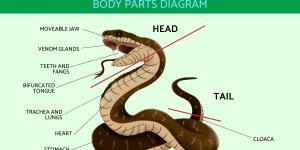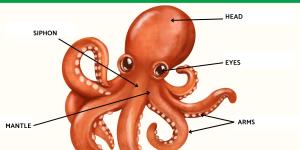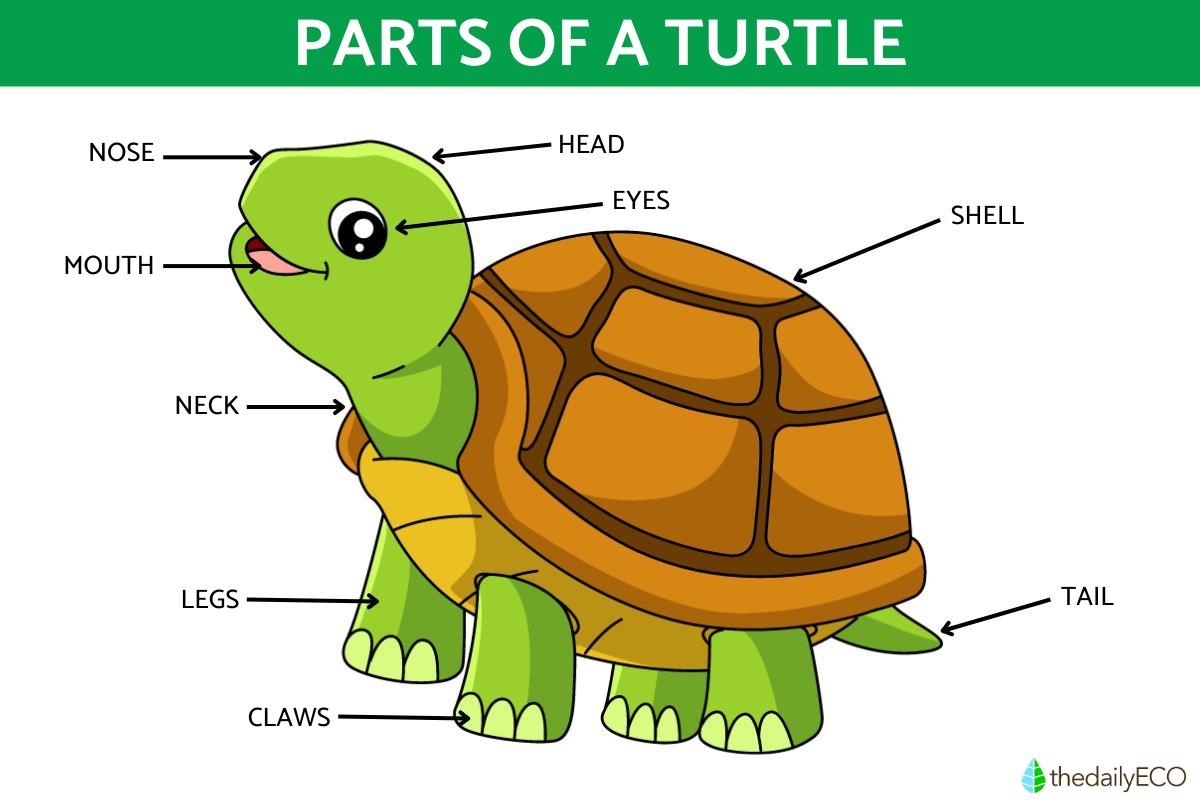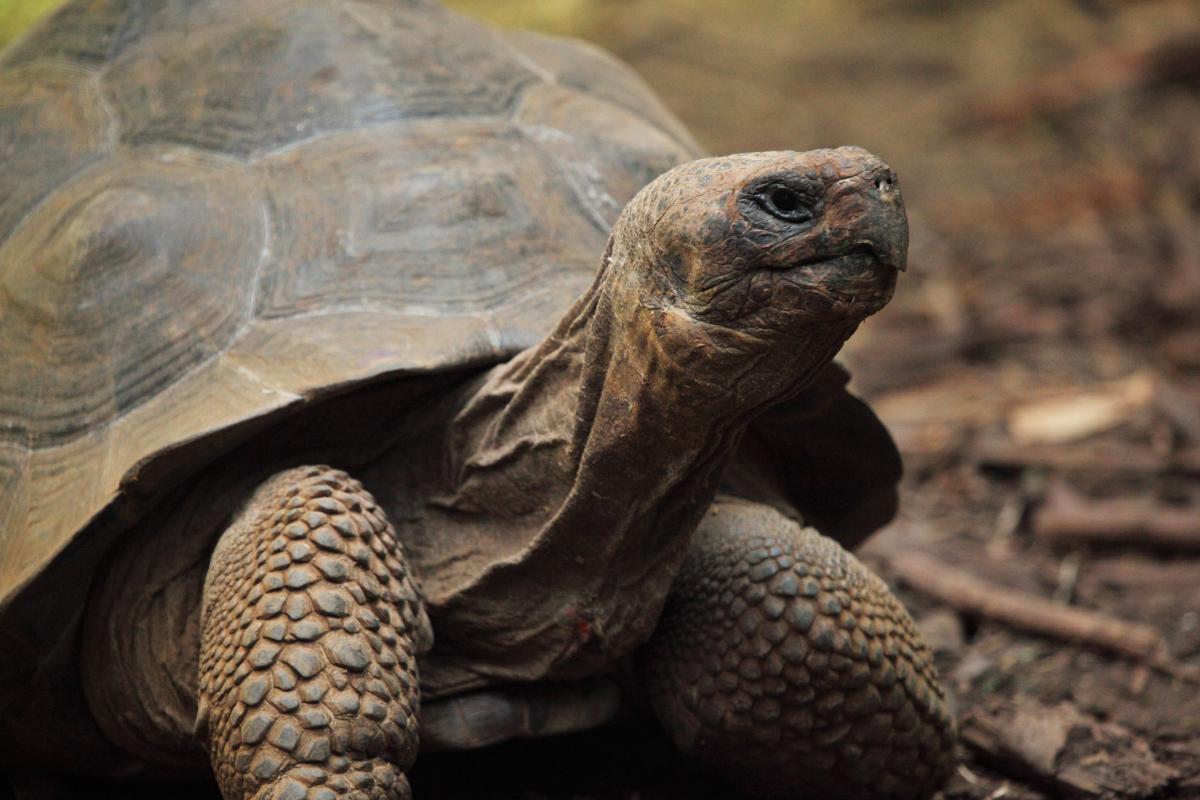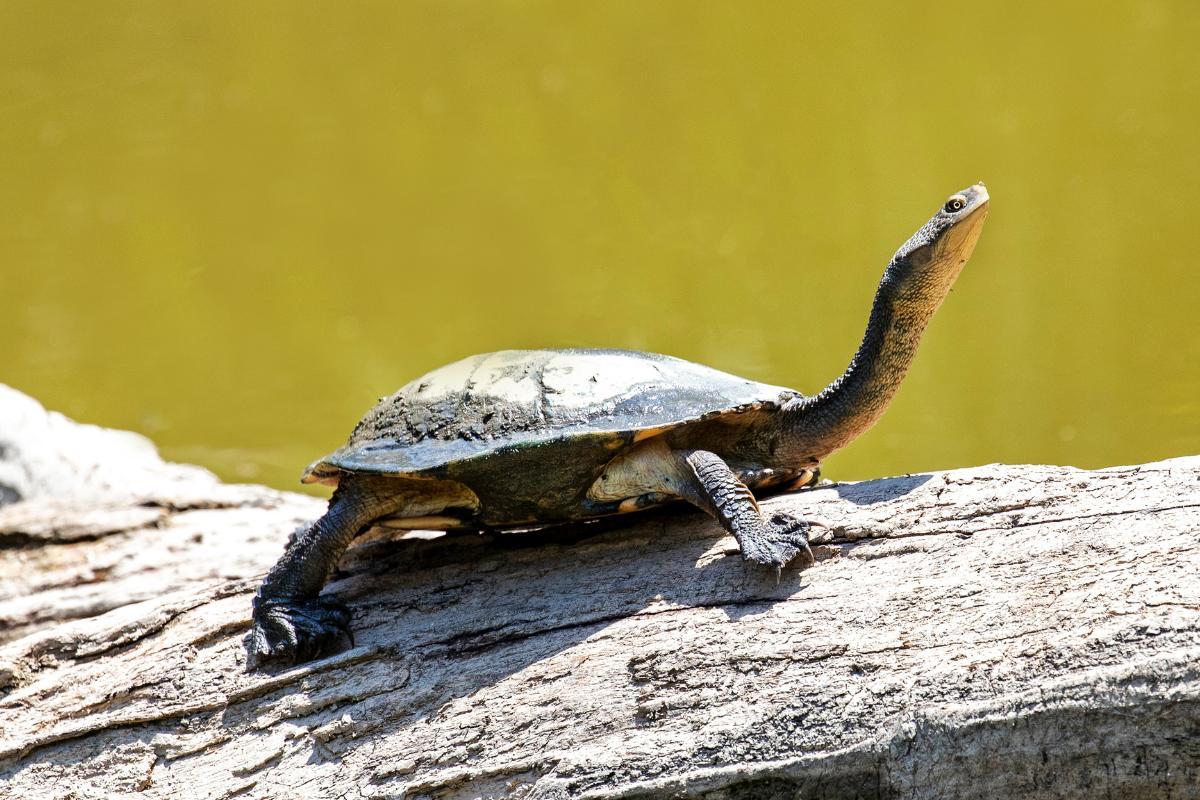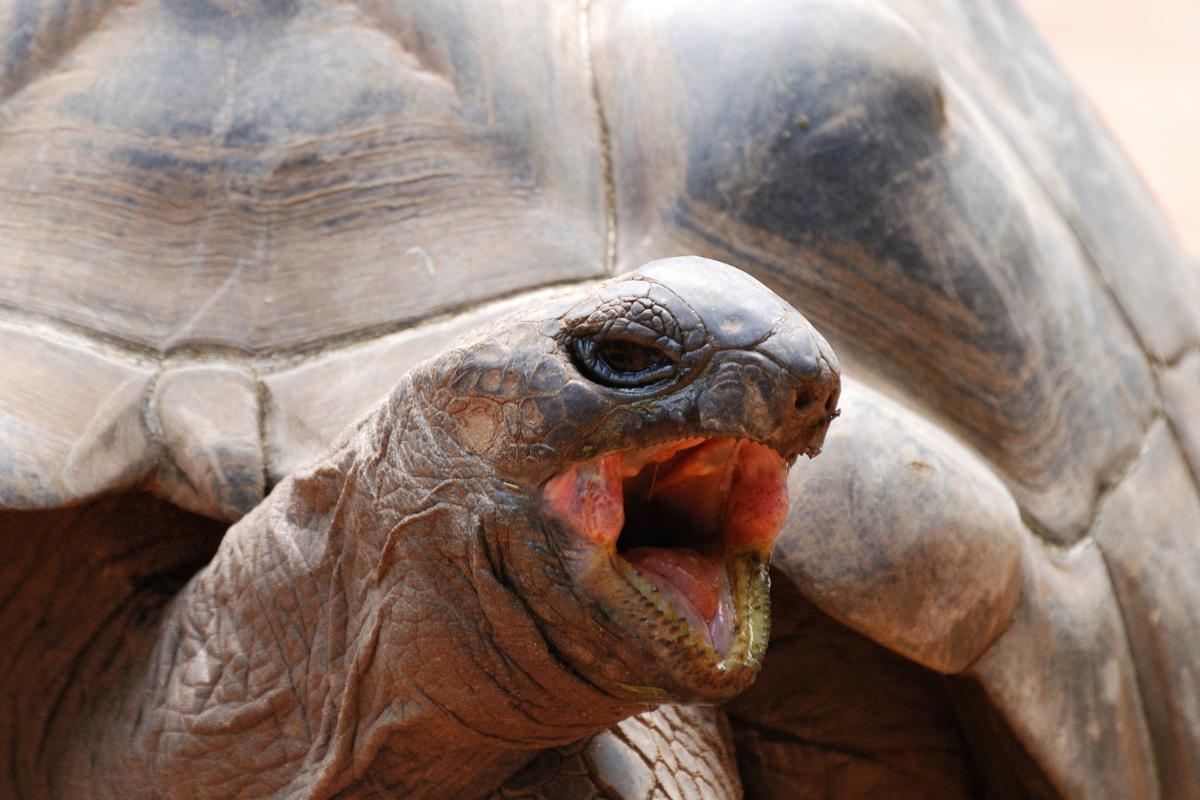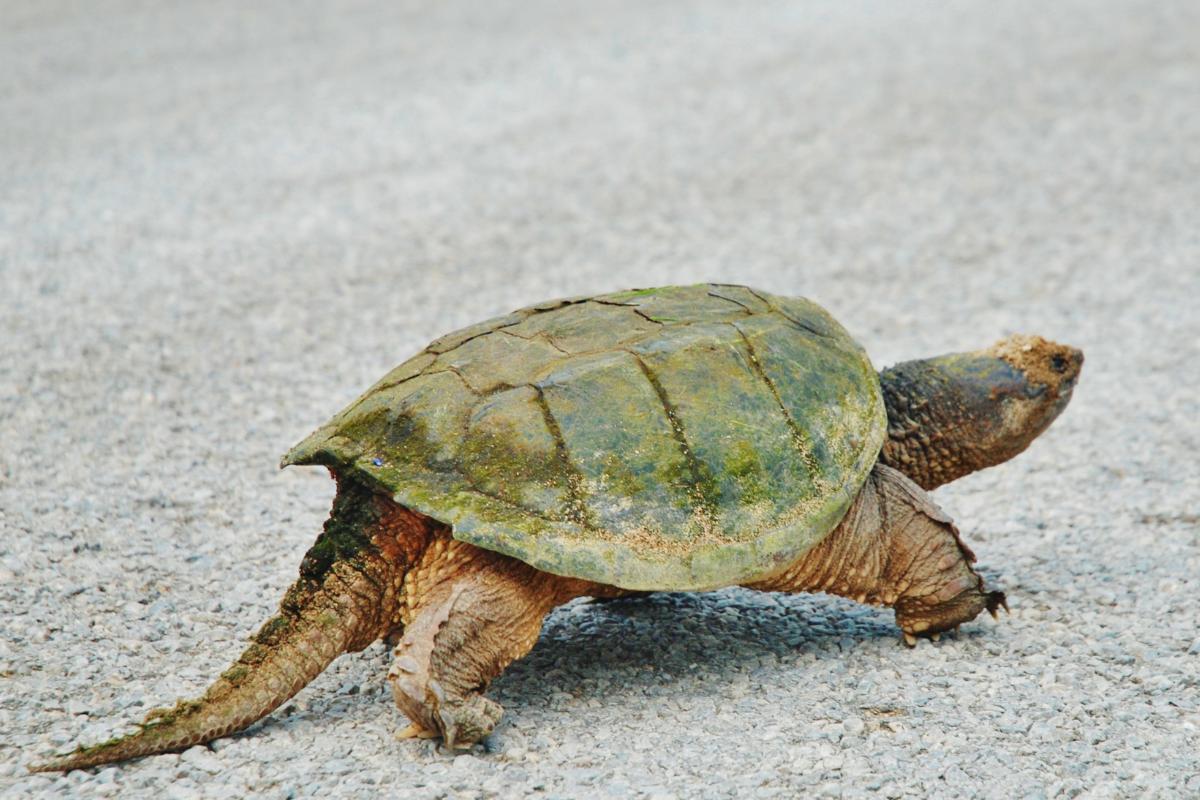Parts of a Turtle


A turtle is known for its shell, from which its body emerges. Despite this hard carapace which it used for shelter and protection, the turtle anatomy include the body parts we expect from most reptiles. These include a head, legs and a tail. While all turtles will have the same basic body parts, some species differ in how they are formed. This is particularly the case when we compare land turtles and sea turtles. Each has legs adapted specifically to life on land or on sea, respectively. Some may also be semi-aquatic.
We get to know basic turtle anatomy better by looking at the body parts of a turtle. We provide a list of turtle parts, as well as a diagram to better illustrate them.
Head
Turtles have smaller heads than most other reptiles. Despite this, they have a relatively large brain compared to amphibians. Turtles are anapsids, meaning their brain is protected by a robust skull with no temporal openings. This is a primitive condition that only exists in this group of living reptiles, perhaps suggesting they have had no need to adapt them throughout their evolution.

Neck
The length of a turtle's neck will depend on their species, with some even having common names referencing this part of their body. They may also differ in how they retract their neck into their shell. The two main categories of turtle according to their neck are:
- Pleurodira: this suborder is also known as side-necked turtles, they retract their necks laterally.
- Cryptodira: also known as hidden-neck turtles, they retract their necks straight back between the shoulder blades.
These movements can be carried out thanks to the morphology and arrangement of the cervical vertebrae. Specimens belonging to the suborder Pleurodira have narrow, coil-shaped vertebrae. IN contrast, those of the suborder Cryptodira have wide and long vertebrae.

Oral cavity
A turtle's jaws lack teeth. Despite this, they can often have a very powerful bite, something useful in cutting plant matter or even breaking down animal shells. In lieu of teeth, a turtle has a rhamphotheca, the outer surface of their beak. This can be smooth or serrated, with each beak differing according to individual species. These morphological adaptations are related to their individual feeding habits, allowing to crush or cut according to their dietary needs.
Turtles are also unlike other reptiles thanks to their tongue. The turtle tongue is equipped with muscle fibers, pigments, taste buds and mucus-producing glands, facilitating the intake and processing of food. In sea turtles and some land turtles, the pharynx has cornified papillae in the terminal portion, extending into the esophagus. These papillae are shaped like sharp spikes and are believed to be crucial for retaining prey such as jellyfish.
Learn more about how turtles feed and their mouth anatomy with our article asking do turtles have teeth?

Shell
Of all the turtle parts, perhaps the most characteristic is their hard shell. While the shell encompasses the entire structure, the doral part is known as the carapace and the ventral part is known as the plastron. The latter forms the underneath which is shaped differently according to sex. The males have a concave plastron, something fundamental in allow them to mate. This is because the male has to climb on top of the female's carapace.
The external layer of the turtle shell is make of keratin, while another internal layer made up of dermal bone. As the turtle grows and ages, new layers of keratin are added under the old ones, forming growth rings that can be used to estimate the age of the turtle.
Unlike what we see in many cartoons or what is represented in popular culture, turtles cannot leave their protective shell. This is part of the animal and includes the vertebrae and ribs, making it impossible to separate it from the rest of the body. Most tortoises can retract their limbs and head into their shell to protect themselves from different threats such as predators. This is not possible with sea turtles.
Although the shell limits chest expansion for breathing, turtles have developed abdominal and pectoral muscles that function in a similar way to the diaphragm in other vertebrates. This is very important in facilitating gas exchange. In fact, the expansion and retraction of the limbs can also modify air pressure.

Extremities
The limbs of turtles vary depending on their habitat. With land turtles, their limbs are usually covered with scales and their toes often end in claws. These have free toes that allow them to move efficiently on land and to dig into the earth. Generally, their legs are short and strong.
In contrast, aquatic turtles have developed limbs adapted for swimming. Their toes are joined by webs between their fingers, creating a fin-like shape that acts as a paddle to facilitate movement in the water. All turtle species use their limbs to dig and cover their eggs once they have been laid in the sand and before they return to the sea.
Learn more about aquatic reptile species with our article asking were there ocean dinosaurs?

Tail
As with the legs, head and neck, the tail is also covered with scales. Its size is an important characteristic when determining the sex of a species. Females have a short tail, but in males it is longer and wider. At the base of the tail is the cloaca, a structure common in reptiles, birds and some mammals. This single opening is used for waste elimination, as well as for reproduction and for laying eggs.

Sense organs
While turtles are able to hear, they do not have external ears like other vertebrate species. This is common in body parts of turtles and other reptiles. Turtles do have middle and inner ears, but their hearing is poor overall. In contrast, their sense of smell and vision are highly acute. They can actually perceive colors in the same way as a human being thanks to rod cells in their eyes.

Reproductive organs
Male turtles have a penis formed by two bands called corpora cavernosa, between which is the spermatic groove. When they fill with blood, the corpora cavernosa lengthen and the penis protrudes from the cloacal wall. When this happens, the groove takes the form of a duct. The females of some species of turtles have a structure homologous to the penis. Although this may not be functional, it is believed that it may act as a complementary portion to the spermatic groove of the male, facilitating sperm transfer.
Now that you know the parts of a turtle, you may also be interested in these articles about the parts of a snake and the parts of an ant in our related anatomy articles.

If you want to read similar articles to Parts of a Turtle, we recommend you visit our Facts about animals category.
- Hickman, C. P., Roberts, L. S., & Larson, A. (2000). “Comprehensive principles of zoology”.
- Kardong, K. V. (2007). “Vertebrates: comparative anatomy, function, evolution”.

